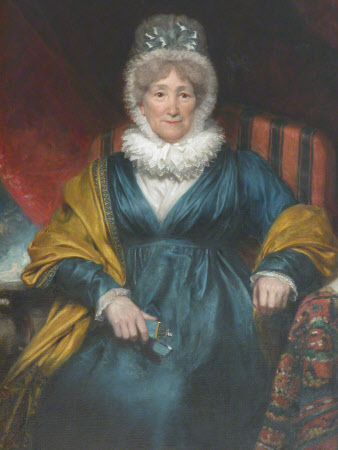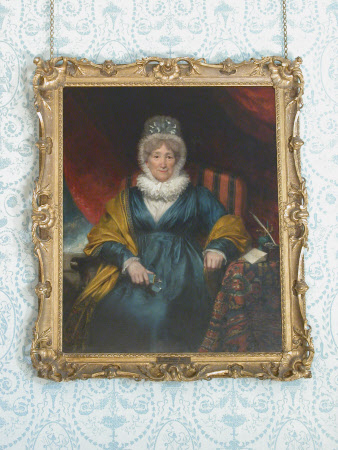Hannah More (1745-1833)
Henry William Pickersgill, RA (London 1782 – London 1875)
Category
Art / Oil paintings
Date
1821 - 1822 (exh at RA)
Materials
Oil on canvas
Measurements
1270 x 1016 mm (50 x 40 in)
Order this imageCollection
Killerton, Devon
NT 922269
Summary
Oil painting on canvas, Hannah More (1745-1833) by Henry William Pickersgill, RA (1782-1875), dated 1821. A three-quarter-length portrait of an elderly woman, full frontal. She is seated on a striped armchair and holds a shagreen spectacle-case in her right hand which lies on her lap, and rests her left arm on the armrest. On the left is a carpeted table on which sits an inkwell and quill, and green wax coil. She wears a dark blue dress with a white undergarment and white frilled lace ruff, a cashmere shawl is draped over her left arm and her right shoulder. She has on an elaborate white lace cap trimmed with light blue ribbons.
Provenance
Commissioned by Sir Thomas Acland, 10th Bt (1787-1871) in 1821 (acc. to inv. card) or 1822 (acc. to the DNB) and given to Sir Thomas’s oldest friend and confidant himself close to the Clapham sect, Sir Robert Harry Inglis, 2nd Bt (1786-1855), by whom left back to ??; lent to the National Trust at Killerton since 19??, acquired as acceptance in lieu in 1995.
Credit line
Killerton, The Acland Collection (accepted in lieu by HM Government and transferred to The National Trust in 1995)
Marks and inscriptions
Recto: Inscribed label Inscription: 34 MRS. HANNAH MORE / BEQUEATHED BY SIR H. INGLIS / (BY PICKERSGILL) Recto: Inscribed on letter: W. Wilberforce Esqr.
Makers and roles
Henry William Pickersgill, RA (London 1782 – London 1875), artist
References
Killerton House, Devon, 2000 [The National Trust] 2000, p.15: "THE DRAWING ROOM Hannah More (1745-1833), by H.W.Pickersgill (1782-1875). 1821. She was an evangelical Christian educationalist, playwright, poet and zealous worker for the abolition of the Slave Trade: the letter by her side is addressed to William Wilberforce, the triumphant champion of the cause. Her religious writings were greatly admired by the Great Sir Thomas, 'that most despotic of tyrants, and most ardent of friends', who comissioned this portrait 'against my most earnest remonstrances and positive refusals'. Sir Thomas's mother was unimpressed: 'I think her the most scrutinizing artful countenance I have seen, rather vulgar in manner, at least certainly not polished." Royal Academy, 1822, No.159

